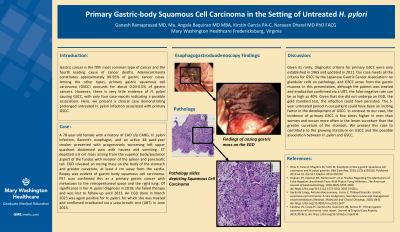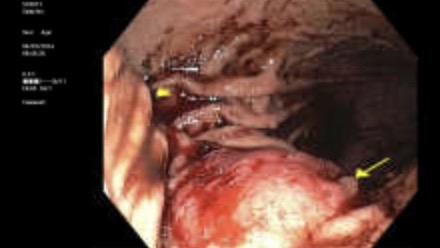Tuesday Poster Session
Category: Stomach
P5075 - Primary Gastric-Body Squamous Cell Carcinoma in the Setting of Untreated H. pylori
Tuesday, October 29, 2024
10:30 AM - 4:00 PM ET
Location: Exhibit Hall E

Has Audio

Ganesh Ramaprasad, MS, MD
Mary Washington Healthcare
Frederickburg, VA
Presenting Author(s)
Ganesh Ramaprasad, MS, MD1, Ma. Angela Baquiran, MD, MBA2, Kirstin Garcia, PA-C3, Narayan Dharel, MD, PhD, FACG1
1Mary Washington Healthcare, Frederickburg, VA; 2Mary Washington Healthcare, Alexandria, VA; 3Mary Washington Healthcare, Fredericksburg, VA
Introduction: Gastric cancer is the fifth most common type of cancer and the fourth leading cause of cancer deaths. Adenocarcinoma constitutes approximately 90-95% of gastric cancer cases. Among the other types, primary gastric squamous cell carcinoma (GSCC) accounts for about 0.04-0.5% of gastric cancers. However, there is very little evidence of H. pylori causing GSCC, with only four case reports indicating a possible association. Here, we present a clinical case demonstrating prolonged untreated H. pylori infection associated with primary GSCC.
Case Description/Methods: A 78-year-old female with a history of CAD s/p CABG, H. pylori infection, Barrett’s esophagus, and an active 48 pack-year smoker presented with progressively worsening left upper quadrant abdominal pain with nausea and vomiting. CT depicted a 6 cm mass arising from the superior body/posterior aspect of the fundus with invasion of the spleen and pancreatic tail. EGD (Figure 1) revealed an oozing mass on the body of the stomach and greater curvature, at least 4 cm away from the cardia. Biopsy was evident of gastric body squamous cell carcinoma. PET scan confirmed this as a primary gastric cancer with metastasis to the retroperitoneal space and the right lung. Of significance is her H. pylori diagnosis in 2018; she failed therapy and was lost to follow-up until 2023. An EGD done in March 2023 was again positive for H. pylori, for which she was treated and confirmed eradicated via a urea breath test (UBT) in June 2023.
Discussion: Given its rarity, diagnostic criteria for primary GSCC were only established in 1965 and updated in 2011. Our case meets all the criteria for GSCC by the Japanese Gastric Cancer Association: no glandular cells on pathology, and GSCC arose from the gastric mucosa. In this presentation, although the patient was treated and eradication confirmed via a UBT, the false negative rate can be as high as 40%. Given that she did not undergo an EGD, the gold standard test, the infection could have persisted. The 5-year untreated period in our patient could have been an inciting factor in the development of GSCC. In contrast to our case, the incidence of primary GSCC is five times higher in men than women and occurs more often in the lesser curvature than the greater curvature of the stomach. We present this case to contribute to the growing literature on GSCC and the possible association between H. pylori and GSCC.
Edited using AI assitance ChatGPT

Disclosures:
Ganesh Ramaprasad, MS, MD1, Ma. Angela Baquiran, MD, MBA2, Kirstin Garcia, PA-C3, Narayan Dharel, MD, PhD, FACG1. P5075 - Primary Gastric-Body Squamous Cell Carcinoma in the Setting of Untreated <i>H. pylori</i>, ACG 2024 Annual Scientific Meeting Abstracts. Philadelphia, PA: American College of Gastroenterology.
1Mary Washington Healthcare, Frederickburg, VA; 2Mary Washington Healthcare, Alexandria, VA; 3Mary Washington Healthcare, Fredericksburg, VA
Introduction: Gastric cancer is the fifth most common type of cancer and the fourth leading cause of cancer deaths. Adenocarcinoma constitutes approximately 90-95% of gastric cancer cases. Among the other types, primary gastric squamous cell carcinoma (GSCC) accounts for about 0.04-0.5% of gastric cancers. However, there is very little evidence of H. pylori causing GSCC, with only four case reports indicating a possible association. Here, we present a clinical case demonstrating prolonged untreated H. pylori infection associated with primary GSCC.
Case Description/Methods: A 78-year-old female with a history of CAD s/p CABG, H. pylori infection, Barrett’s esophagus, and an active 48 pack-year smoker presented with progressively worsening left upper quadrant abdominal pain with nausea and vomiting. CT depicted a 6 cm mass arising from the superior body/posterior aspect of the fundus with invasion of the spleen and pancreatic tail. EGD (Figure 1) revealed an oozing mass on the body of the stomach and greater curvature, at least 4 cm away from the cardia. Biopsy was evident of gastric body squamous cell carcinoma. PET scan confirmed this as a primary gastric cancer with metastasis to the retroperitoneal space and the right lung. Of significance is her H. pylori diagnosis in 2018; she failed therapy and was lost to follow-up until 2023. An EGD done in March 2023 was again positive for H. pylori, for which she was treated and confirmed eradicated via a urea breath test (UBT) in June 2023.
Discussion: Given its rarity, diagnostic criteria for primary GSCC were only established in 1965 and updated in 2011. Our case meets all the criteria for GSCC by the Japanese Gastric Cancer Association: no glandular cells on pathology, and GSCC arose from the gastric mucosa. In this presentation, although the patient was treated and eradication confirmed via a UBT, the false negative rate can be as high as 40%. Given that she did not undergo an EGD, the gold standard test, the infection could have persisted. The 5-year untreated period in our patient could have been an inciting factor in the development of GSCC. In contrast to our case, the incidence of primary GSCC is five times higher in men than women and occurs more often in the lesser curvature than the greater curvature of the stomach. We present this case to contribute to the growing literature on GSCC and the possible association between H. pylori and GSCC.
Edited using AI assitance ChatGPT

Figure: Figure 1 Oozing mass in the body of the stomach
Disclosures:
Ganesh Ramaprasad indicated no relevant financial relationships.
Ma. Angela Baquiran indicated no relevant financial relationships.
Kirstin Garcia indicated no relevant financial relationships.
Narayan Dharel indicated no relevant financial relationships.
Ganesh Ramaprasad, MS, MD1, Ma. Angela Baquiran, MD, MBA2, Kirstin Garcia, PA-C3, Narayan Dharel, MD, PhD, FACG1. P5075 - Primary Gastric-Body Squamous Cell Carcinoma in the Setting of Untreated <i>H. pylori</i>, ACG 2024 Annual Scientific Meeting Abstracts. Philadelphia, PA: American College of Gastroenterology.

